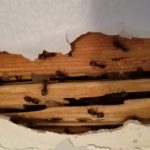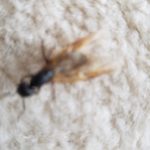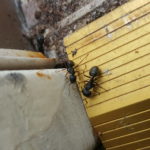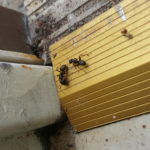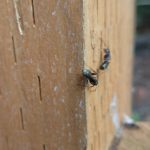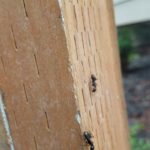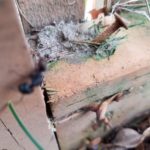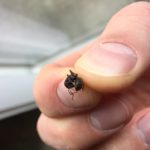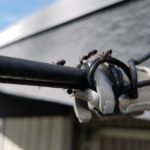LOCAL KING COUNTY WASHINGTON CARPENTER ANTS PEST CONTROL
Buildings of age or type of construction with condition conducive to ants nesting to service and feed, are vulnerable to infestation and damage by carpenter ants.
Carpenter ants are very difficult to control remove spray and exterminate. carpenter ants winged individuals often indicate a well-established colony. Sign of carpenter ant activity is the debris they produce from tunneling in the wood. Rough wood shavings mixed with parts of dead ants from the colony indicate carpenter ant nesting activity. Sound sometimes heard as the ants go about their activity in the home’s wood.
Ants of the genus Camponotus are known as carpenter ants because they prefer to establish their colonies in galleries excavated from damp or damaged wood. Carpenter ants do not eat wood as termites do, but instead remove wood and deposit the debris outside of their nests in small piles.Carpenter ants clean their nesting sites, and their galleries are not lined with mud or moist soil as termite galleries typically are. Carpenter ant workers keep their galleries as smooth as sandpapered wood.
Big Black Ants marching and flying in the house problems of pest control:
There is one thing most people don’t think about. That is the home getting infested with a damaging ant species. But the moment came when the big Black Ants have infiltration into the home. Exactly what type of ant or bug is it. Recently, the Greater Seattle area has been plagued with Carpenter Ants. Homes and commercial business owners are great targets for this type of invasion. A Seattle homeowner saw the first big ant in the garage and then on the sundeck. But unsure of what the pests were the owner decided to investigate with taking a picture to submit to a pest control expert. An emailed photo was sent to a professional Pest Control company for verification. All known facts about what had been observed were included in the email. The number one choice was to contact AMPM Exterminators.
Seattle homeowners fight and kill carpenter ants nightmare about to become reality:
The homeowner pulled into the garage. Happy the work day was over and looking forward to getting some rest. But something flew by like a bat out of hell. It came to a stop right at the entry door to the home. The owner was able to capture the bug with a paper towel and took a picture. As soon as the owner entered the house the wife was clearly distraught about big black bugs out on the patio and flying through the open door. One of the kids had forgotten to close the screen door. The husband took a look around inside and outdoors. The Carpenter Ants were working on the patio big time. Annoyed and stressed decision was made to notify a professional pest control company. AMPM Exterminators was sending out a technician shortly.
Identifying Carpenter Ant Control problems in commercial business buildings:
The nest may be located by careful observations of worker ants, especially between sunset and midnight during spring and summer months when carpenter ants are most active. To follow carpenter ants without startling them, use a flashlight with a red film over the lens—ants cannot see red light. You can also cover part of the flashlight with your hand so the light is more indirect and is not as bright. You can increase your chances of following workers to their nest by setting out food that is attractive to carpenter ants. Place food in areas where you find workers.
Many foods are attractive to carpenter ants, including honey or other sweet foods. During spring, carpenter ants are particularly attracted to protein sources, such as tuna packed in water. (Carpenter ants are not attracted to tuna packed in oil.) Set out small pieces of tuna for the ants to take back to their nest. It is easier to follow the ants when they are carrying food. With patience and perseverance, you can follow the ants back to their nest. If you put pieces of fish in many areas, food placed closer to the nest or trails will be found sooner.
It is not the norm to be able to identify species of bugs much less all ants species. The Queen Carpenter ants measure about 3/4 inch are large and Workers around 1/4-1/2 inch. Winged Carpenter are the aces and are always in flight to establish new colonies. Different colored carpenter ants found in the State of Washington. Some of which are red or black. However, the most common Carpenter Ant is black with reddish legs. Carpenter ants actually do not eat wood. The pests gnaw on wood like a planer smoothing out wood. The Big Black ants can enlarge nests by tunneling into the wood. The scary thing is that the infestation may be more widespread throughout the structure than realized.
Get Rid Of Carpenter Ants – Do It Yourself Pest Control being destructive:
A Carpenter Ant infestation is something a homeowners dreads. The pests create a lot of damage to structures simply through the nesting process. The pests complex life cycle and nesting habits are big threats to residences and commercial businesses. Mutual feelings were shared by the homeowners that the big black ants had to go. How to get rid of the Carpenter Ants was put into the hands of experience. It was perfect time to contact a Pest Control Exterminator.
carpenter ant commercial home pest control
An assessment would be done to locate where the Carpenter Ants were nesting. A pest control work plan would be drawn up to exterminate the main colony. Main colonies are commonly found outside. But may also be found inside walls, in ceilings, below outdoor siding, in piles of wood by foundations. Also may be found near downspouts, gutters, within floors and insulation. A huge factor are specific trees found near the home. Once the professional carpenter ant infestation expert arrived from AMPM Exterminator the investigation begun. The homeowner was grateful for the expedited service and carefully listened to the prevention tips given by the technician. The homeowner booked a recurring monthly service.
Professional pest control company with exterminators for Carpenter Ants, bed bugs, little black sugar ants, rat and mice control, birds, beetles, moths, flies, termites, wasps, yellowjackets and hornets and much more. Ampm Pest Exterminators takes pride in family and pet friendly effective pest control in King County areas of Seattle, Bellevue, Redmond, Kirkland, Renton, Everett, Bothell and Issaquah and mzny many other cities. All services are available to residential including single family residences, apartments, Commercial Businesses such as hotels, restaurants, schools and industrial establishments including warehouses and grocery stores. Attic and Crawlspace Rodent Restoration including cleaning, sanitizing and insulation removal & repair after rats, mice, squirrels, birds, bats Infestation.
Call AMPM Exterminators for answers to questions about costs and product usage. Yes, Green. It is much easier, faster and cheaper to get rid of any pest by using a professional service. Every home is different and if any repair costs are provided the cost may vary. After years of experienced inspections this client deserved customized solutions for the Big Black Carpenter Ant Infestation. Which AMPM Exterminators did with great success.
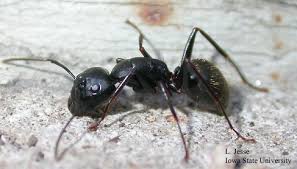
Velvety tree ants eat honeydew, nectar, and insects. They tend small insects, like aphids, because they produce honeydew: Ants control service,ants extermination,ants elimination service,ants removal service,little black ants exterminators,sugar ants
http://bit.ly/2eQHYPZ
